The Duroc pig is a highly regarded breed in the world of pig farming.
Known for its distinctive characteristics, including robust health, rapid growth, high meat quality, and numerous other benefits, Duroc pigs have earned a reputation as a valuable addition to any farm.
Exploring this article, you will find everything you need to know about the key qualities that make the Duroc pig a popular choice among farmers and why it is worth considering for your livestock operation.

You can also consult our pig breeds list to compare Duroc and other breeds to determine which one is the best choice for you.
Short summary of the Duroc pig
| Good for: | homesteaders, small farms, commercial farming |
| Size: | medium to large size |
| Color: | reddish-brown |
| Lifespan: | 15 to 20 years |
| Growth Rate: | growing really fast |
| Weight: | boar: up to 882 lbs (400 kg), sow: up to 772 lbs (350 kg) |
| Sexual maturity: | 6 to 7 months of age |
| Slaughtered age: | 4.5 to 5 months of age |
| Litter size: | 10 to 15 piglets |
| Price: | $50-$100 for a piglet and $200-$350 for an adult pig, depending on the quality, breeder, etc. |
What is a Duroc pig?
Duroc is an old domestic pig breed that originated in the United States and continues to be one of the major breeds in many countries.
Duroc Pig Characteristics
Physical Characteristics
The Duroc pig’s physical characteristics, such as its distinctive color and ears, make it stand out among other pig breeds.
Color
Duroc pigs have a reddish-brown color.
Is Duroc always a solid red or reddish-brown? No, Duroc is not always a solid red.
Their coloration can range from a very light golden to a deep mahogany red, covering the entire body, including the face.
Skin and Coat
The skin is smooth and has a white to pink to light gray color.
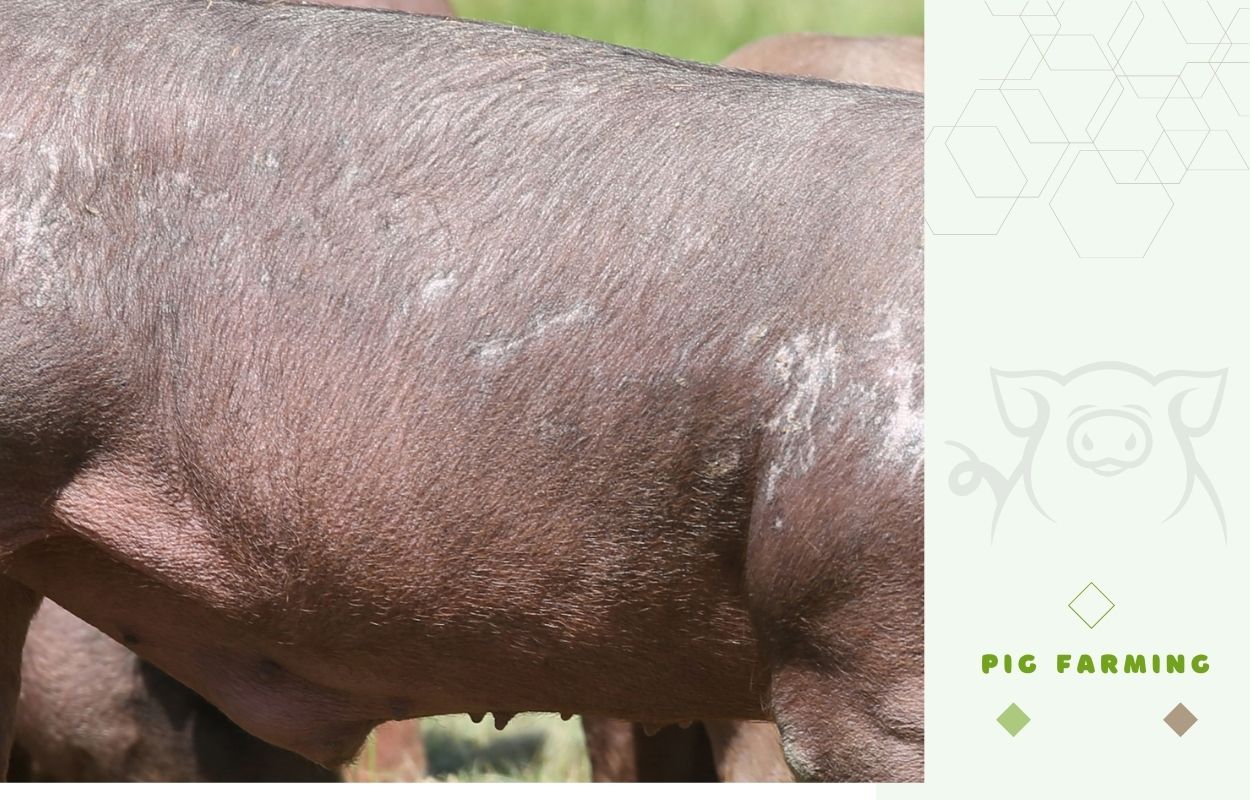
Also, their entire body is covered in hair that becomes thicker in winter and finer in summer.
The hair is straight.
Head, Face, and Ears
The Duroc’s head is small compared to the rest of the body.
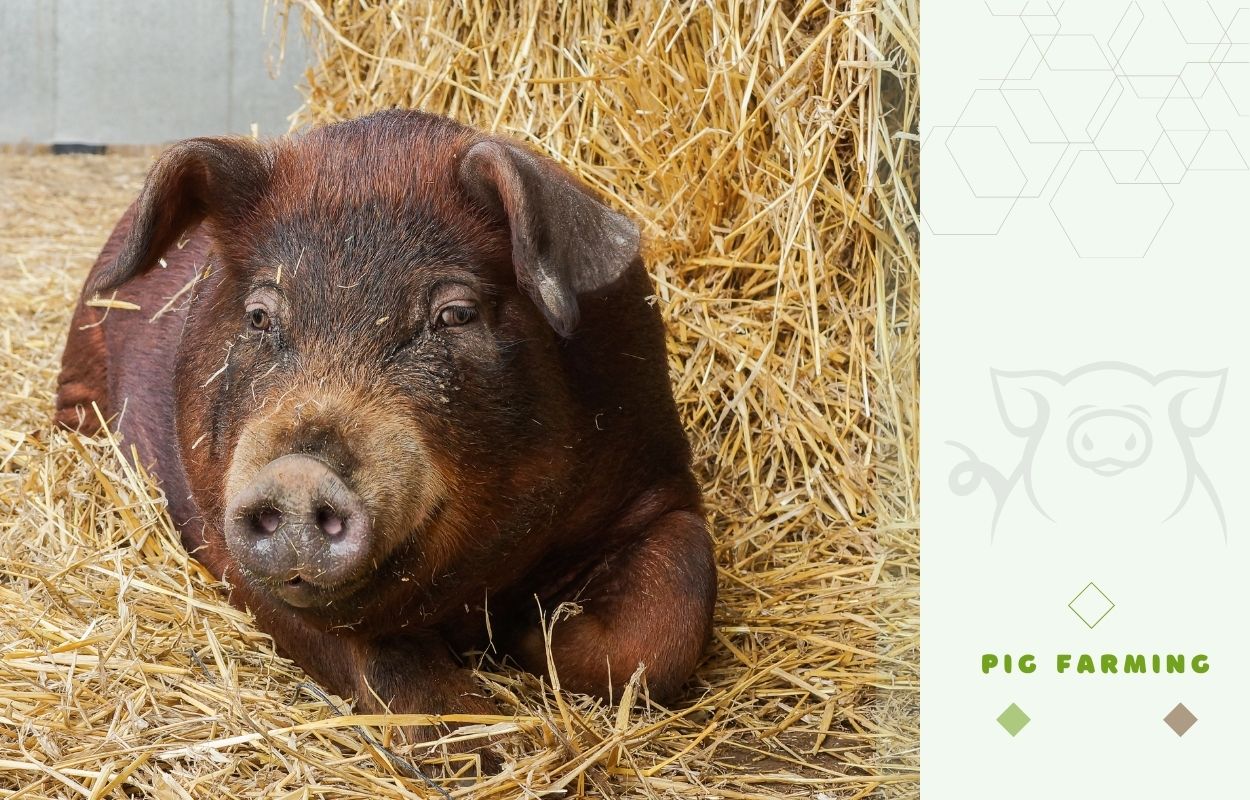
Like the head, the face is also small and has a slightly dished appearance, gradually narrowing down to the nose. The surface of the face is smooth and even as well.
The eyes are well set apart with a noticeable gap between them.
The ears are of medium size, moderately thin, and have a slightly drooping or forward-pointing orientation.
Duroc’s ears are never erect.
The ear coloration in Duroc pigs matches their body color.
Neck and Shoulders
The neck of the Duroc pig is short, thick, deep, and slightly arched, while the jowl is full and broad.

The shoulders are proportionate to the overall body size. They are moderately wide, exceptionally deep and full, with thickness extending gracefully downward and not rising above the level of the back.
Chest, Back, Ribs, Sides
The chest of this pig is large, deep, and filled behind the shoulders, with the breastbone extending prominently forward.
The back is mostly flat or straight, with a slight arching upwards that helps maintain an even width from shoulder to ham. When viewed from above, the width from front to back is consistent.
The ribs are long and sturdy, appropriately curved in relation to the width of the shoulders and hams.
The loin has a consistent width from the shoulder to the ham, while the sides are deep with medium length and remain level between the shoulders and hams.
The hams are broad, full, and extend down to the hock, while the rumps have a rounded slope from the loin to the base of the tail.
Legs
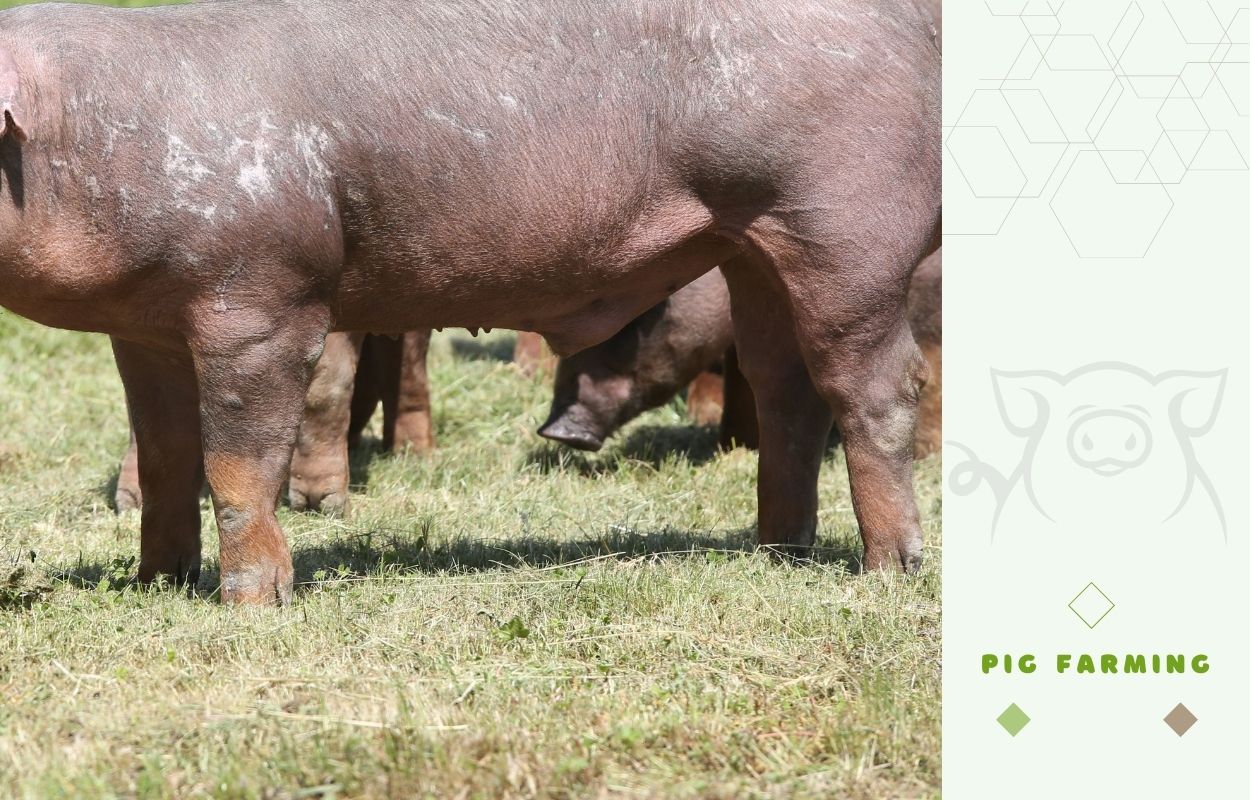
The legs of Duroc pigs, especially in boars, are very strong and of medium length, providing excellent support for the overall weight of the body.
Belly, Teats, Tail
Duroc, like the other brown pig breed Red Wattle, has a belly that tucks inward into the abdomen, as opposed to protruding outward like a Vietnamese Pot-belly pig.
When it comes to teats, this pig has between 12 to 14, which are evenly spaced from each other.
The pig’s tail is also reddish and stands straight up.
Duroc pig’s size
Duroc has a medium to large size.
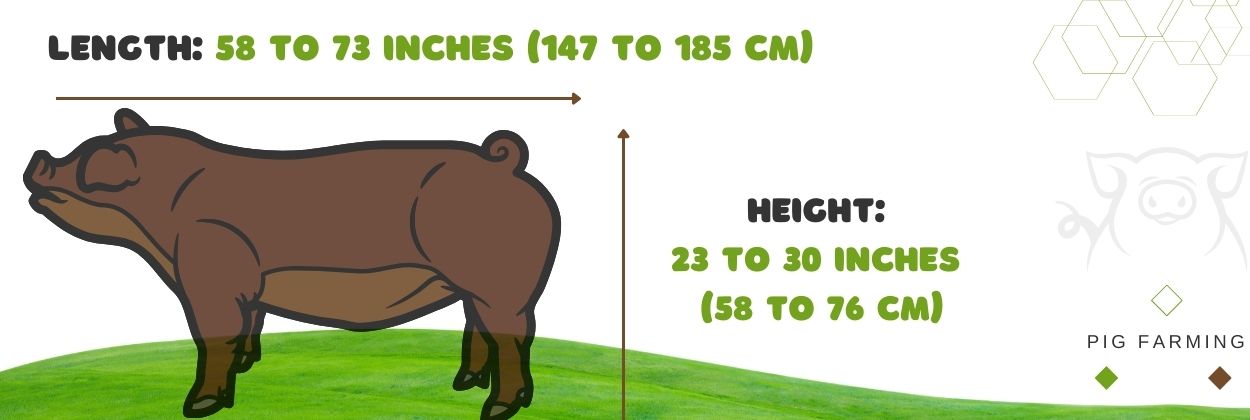
An adult Duroc pig has a height of 23 to 30 inches (58 to 76 cm) at the shoulder and a length of 58 to 73 inches (147 to 185 cm) from the tip of the nose to the base of the tail.
As with many other pig breeds, Duroc sows and gilts are slightly smaller in size compared to Duroc boars.
These dimensions can vary depending on factors such as age, genetics, and how they are cared for.
Duroc’s Lifespan
Duroc pigs live for 15 to 20 years.
The lifespan of this pig breed is among the longest, similar to heritage pig breeds such as Mangalica.
Duroc’s Growth Rate
How fast do Duroc pigs grow?
Duroc pigs grow really fast, reaching a good weight at 4.5 to 5 months of age.
They reach the maximum total weight at 2 to 2.5 years of age. Durocs are known for being one of the fastest-growing commercial pig breeds under 5 months.
As for their sexual maturity, they reach it starting at 6 to 7 months of age, which is a very young one compared to other types of pigs.
Weight
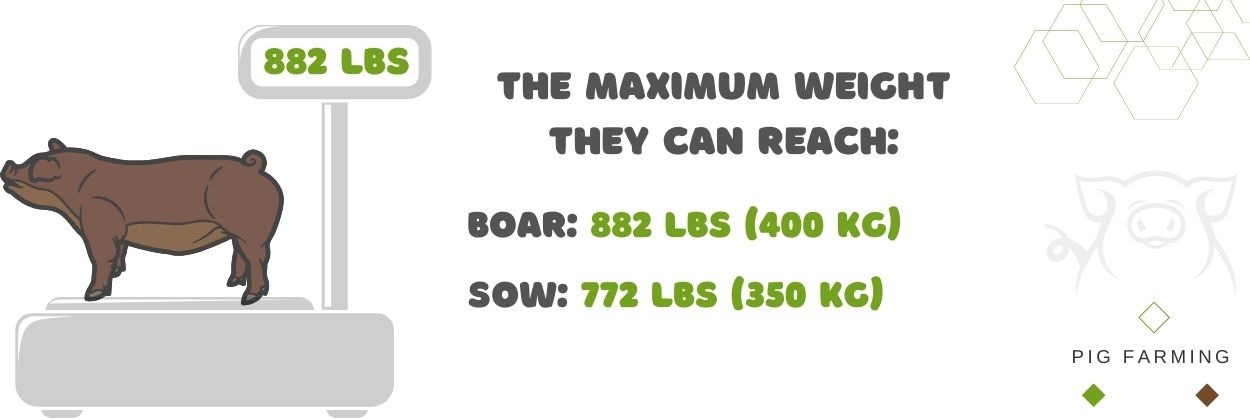
An adult Duroc boar can weigh up to 882 lbs (400 kg). An adult Duroc sow can weigh up to 772 lbs (350 kg).
A Duroc pig can gain a minimum of 1.43 to a maximum of 3.00 lbs (0.64 – 1.4 kg) per day at 3-4 months depending on the diet and the type of environment.
The average daily gain of a Duroc is lower than that of a Yorkshire or Landrace pig according to studies.
Slaughtered Age
Duroc pigs can be slaughtered at 4.5 to 5 months of age, when they also reach a weight of 200 lbs (90 kg).
With the right nutrition, vitamins, and minerals, they can even reach a weight of 230 lbs (105 kg) at 5 months and 280 lbs (127 kg) at 7 months.
Also, a Duroc pig can provide you with 75% of the hanging weight in meat.
Given that they weigh 200 lbs (90 kg), you can get 150 lbs (68 kg) of meat.
Temperament and Behaviour
The temperament of a Duroc pig is highly influenced by how it is raised.
There is a general perception that Duroc pigs can have aggressive behavior and a challenging temperament.
This is partially true, especially when considering their raising in a confined environment like pens for the commercial pork industry.
When raised in limited space with no interaction with other pigs, animals, or human contact, they tend to become agitated and can be difficult to manage.
But, if they are raised in a free-range environment with access to pasture and socialization opportunities with other pigs and various animals, Duroc pigs are generally docile, calm, friendly, and easy to work with.
If they are trained and exposed to human interaction from a young age, they have good behavior.
Duroc pigs enjoy interacting and sharing their space with other pigs. They are curious animals and often explore their living space enthusiastically, sometimes even attempting to escape for more adventures.
They can thrive independently and, despite having socialization skills, they do not always require constant attention or petting.
Duroc pigs have a strong inclination to root and forage throughout the day, which keeps them occupied and mentally stimulated.
Overall, Duroc pigs are great to raise due to their obedient and docile nature, as long as they are not raised in confined spaces for commercial purposes.
Duroc Pig Meat
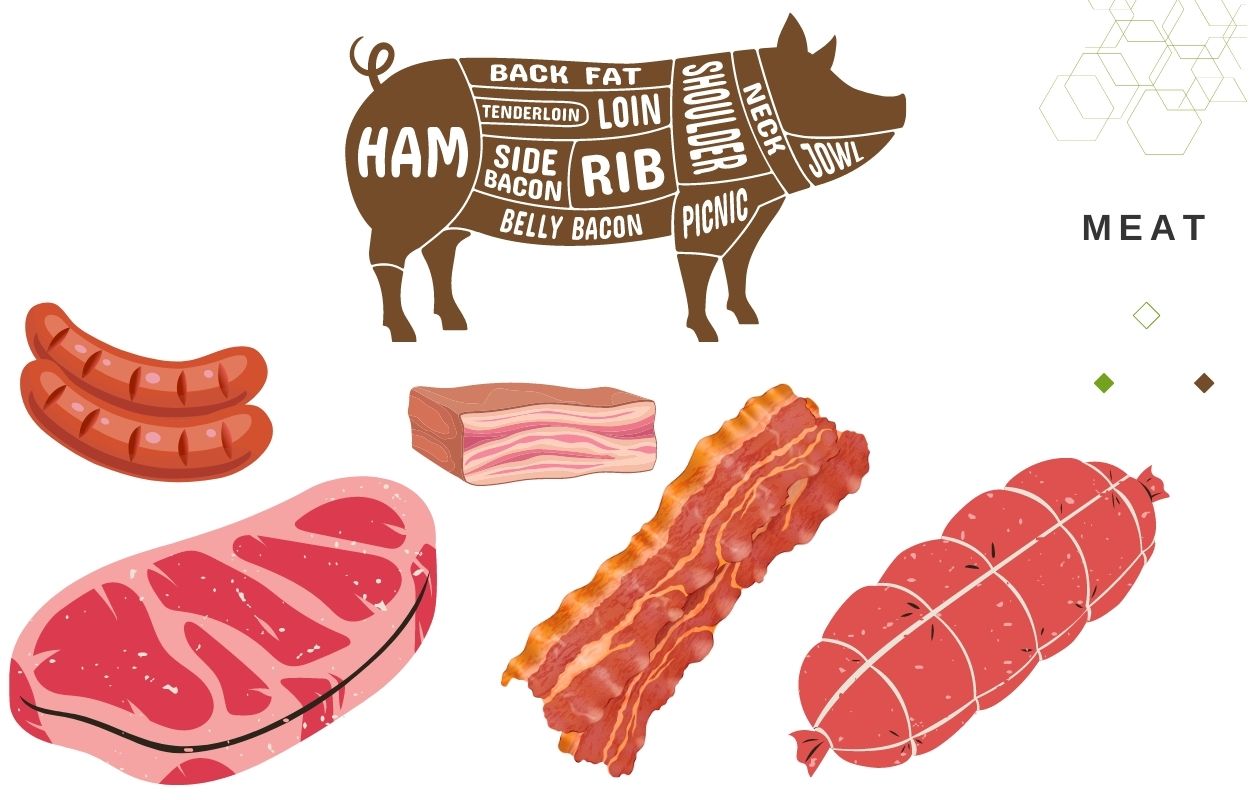
Duroc meat has a superior quality, highly recognized by chefs all over the world.
The meat is dark red and has a good ratio of lean to fat, making it neither too lean like Pietrain meat nor too fatty like Mangalica meat.
Duroc meat is well-marbled, and this marbling helps it to remain juicy and flavorful even after proper cooking.
Duroc pork is in high demand for barbecue and smoked meat preparations because it excels at preserving moisture and flavor when subjected to slow cooking methods.
While Duroc meat is marbled, the fat is often considered healthier than in other breeds because it contains a higher percentage of unsaturated fat.
The texture of the meat is also very tender. The flavor of the meat is milder compared to other types, for example, Berkshire pork.
Also, Duroc meat has a higher fatty acid content than Berkshire pigs, qualities that classify its meat as of greater quality than Berkshire. Another aspect of its meat is its higher pH, more marbling, less drip loss, and greater color than Yorkshire and Landrace meat.
When it comes to vitamins and minerals, Duroc meat offers a significant amount of vitamins B6, B12, zinc, and iron, more than beef meats.
Another demonstration of the high quality of Duroc meat is the fact that this pig breed is used in diverse crossbreeding programs to improve the meat quality of other pig breeds, as this study states.
Duroc meat is widely used in pork production for ham, sausages, bacon, and steaks.
Raising Duroc Pig
Feeding
You can feed Duroc pigs grains like corn, barley, wheat, and oats, as these provide energy and carbohydrates. You can also feed them fruits, vegetables, kitchen scraps like vegetable peels, bread, or leftover grains, and dairy products.
Depending on the farm setup or environment in which they are raised, you can allow them to graze and root for natural food sources. Being overly curious and excited, they will enjoy themselves with lots of plant-based protein, worms, insects, bugs, and roots.

Another feeding alternative for Duroc pigs, if you do not have the possibility to offer them a diet full of fruits, vegetables, and grains, is to feed them with commercial pig feed. They also develop well on this type of feed.
There are different types of pig feed available, including starter, grower, and finisher feeds, designed for various stages of growth. The only downside to commercial pig feed is that the meat will be different from that of pigs raised outdoors and fed with no commercial pig feed.
Durocs have great feed efficiency, tending to gain more muscle and weight while consuming less food than other pig breeds.
What not to feed Duroc pigs:
You should avoid feeding Duroc pigs moldy, salty, or sugary foods, as these can cause various digestive issues.
It is also recommended not to feed them meat or meat products for the same reason.
Duroc pig food intake varies depending on the climate they are raised.
In hotter climates, these pigs tend to reduce their feed intake due to the heat generated during digestion.
In such situations, to achieve the same results, it is recommended to offer them a low crude protein diet, provide food during the cooler parts of the day, such as early in the morning or late in the evening, and feed them multiple times a day in smaller portions to minimize the energy required for digestion.
As for feed quantity, a Duroc pig can consume up to 6.5 lbs (2.9 kg) of feed daily, and pregnant sows may eat up to 7.5 lbs (3.4 kg).
Remember that these pigs need to have access to a constant, fresh source of water too. Water plays an important role in vital bodily functions, including growth, reproduction, regulating body temperature, absorbing and transporting nutrients, excreting waste, lubricating joints, and cushioning nerves.
The amount of water a pig needs primarily relies on its body weight, feed intake, and environmental temperature.
Heavier pigs require a greater water intake to sustain their bodies compared to lighter animals.
Environment
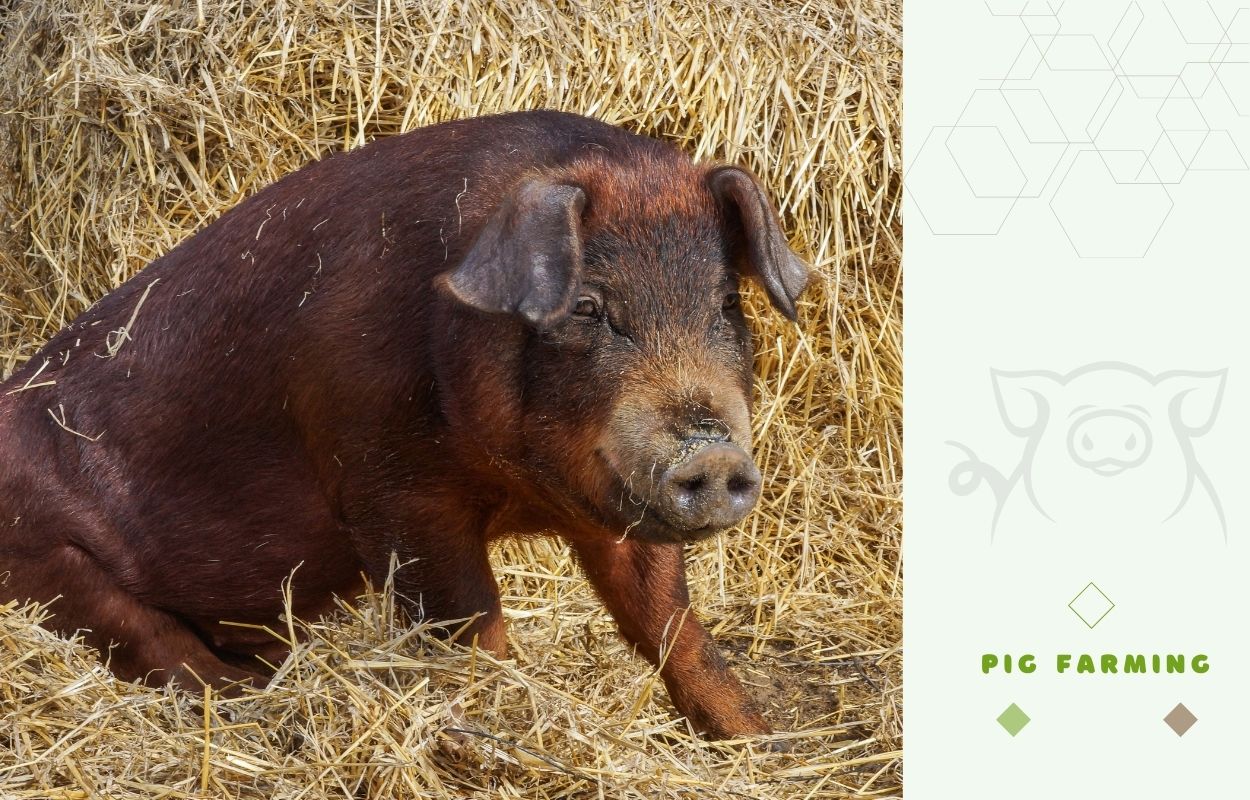
The ideal environment for Duroc pigs is one that offers them freedom, with unrestricted access to pastures and grasslands that are shared with other pigs or farm animals. Such living conditions help keep them calm and make them docile animals.
While it’s not impossible to raise them in enclosed spaces, it is not recommended. In confined spaces, they become difficult to handle and work with. They are not adaptable and tend to exhibit aggressive behavior.
Climate
Duroc pigs can easily adapt to all types of climates.
They thrive and tolerate both hot and cold weather conditions well, provided they have the right environment.
In cold temperatures, their fur becomes thicker, while in hot weather, they shed.
Shelter
Duroc pigs need shelter with clean bedding and a sturdy electric fence to protect them from various environmental factors and to keep predators at bay.

The shelter provides protection from extreme weather conditions, including heavy rain, strong winds, and extreme hot or cold temperatures. The clean bedding inside the shelter helps them stay comfortable and healthy, especially during winter.
Additionally, the shelter provides them with a calm environment that reduces their stress.
Pregnant sows also require shelter for giving birth and caring for piglets. The part of the shelter where piglets are born needs temperature management.
How many Duroc pigs per acre?
You can raise up to 30 Duroc pigs per acre.
The number can vary depending on factors such as total land size, the age of the pigs, and the quality of the vegetation.
Breeding Duroc pigs
Breeding Duroc pigs involves selecting the right female and male Durocs with the appropriate Duroc traits and ensuring their good health.
This is one of the most important steps to ensure that only desirable traits like good conformation, temperament, and genetic qualities are passed on to their offspring.
Both Duroc gilts and boars can be bred at the age of 6 to 7 months.
Breeding can occur through natural mating, allowing them to mate on their own, or through artificial insemination.
Because they do not encounter many issues during the mating process, most farmers opt for the traditional natural mating method.
Just like with any other pigs, you must first ensure that the Duroc gilt or sow is in heat. Look for signs such as increased vocalization or swelling of the vulva.
Duroc sows typically experience a heat period every 21 days. Once the sow is in heat, introduce her to the boar and allow them to mate.
The Duroc sow has a gestation period of 114 days, which is equivalent to 3 months, 3 weeks, and 3 days.
Duroc has a litter size of 10 to 15 piglets.
The mortality rate among piglets is quite low, especially when they have the right conditions.
According to this study, Duroc piglets are generally hardier and stronger at birth compared to, for example, Pietrain piglets. The sows are known for their good mothering skills, providing good care for the piglets.
However, the Duroc pig breed holds a unique position in the breeding topic. Why?
Duroc pigs are considered a terminal breed primarily raised for commercial pork production.
Despite their terminal status, Duroc pigs play a significant role in crossbreeding programs worldwide.
Duroc pigs are crossbred with other pig breeds to enhance the quality of the carcass and meat. They are often referred to as the ‘meat-improver’ pig breed.
Some common crossbreeds with Duroc pigs include:
- Duroc and Yorkshire
- Duroc and Hampshire
- Duroc and Landrace
- Duroc and Tamworth
- Duroc and Crossbred Sows
Vaccination

If you are raising Duroc pigs on a larger scale, it is recommended to vaccinate them according to the standard vaccine schedule for pigs to protect against common pig diseases.
If you are raising only a couple of them on a small farm or homestead and maintain a clean environment with clean bedding and living areas, then you have the option to skip vaccinations.
But, if you want to ensure their health and prevent illnesses, you can choose to vaccinate them.
Duroc Health Issues
Duroc pigs are known for their hardiness and resistance to various diseases, making them relatively robust.
However, they can still be susceptible to certain health issues, including:
- Respiratory infections caused by viruses and bacteria.
- Parasitic infections from internal and external parasites like worms, ticks, and mites.
- Obesity, particularly when overfed or lacking exercise.
- Heat stress, especially in hotter climates.
- Skin issues such as mange.
Why should you raise Duroc pigs?
Duroc can be a great pig breed for homesteaders, especially for those who do not want to invest a significant amount of time or money in raising pigs.
Providing a shelter, a fresh water source, clean bedding, and some space for them to run and socialize is sufficient for this type of pig.
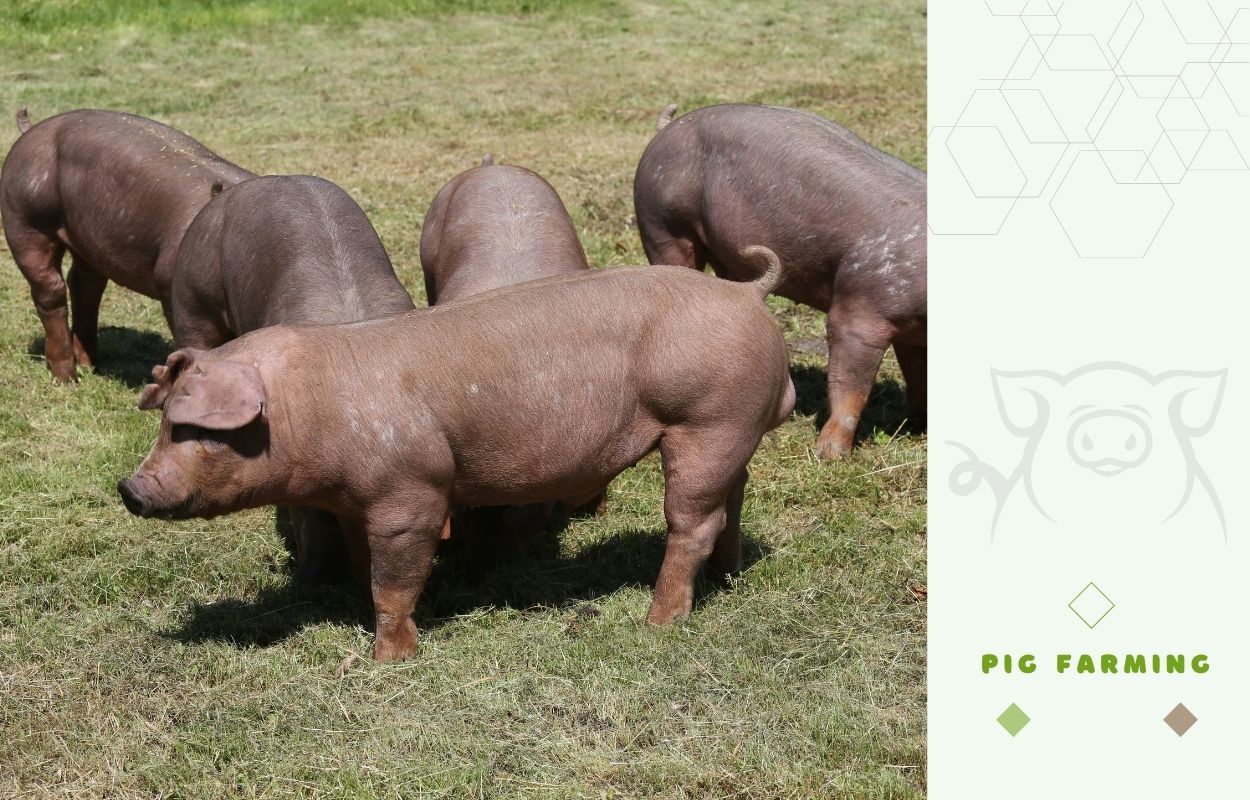
Raising Duroc pigs on homesteads yields high-quality, well-marbled meat that is highly regarded by top restaurants and chefs.
The substantial amount of meat obtained from Duroc pigs can be used in various cooking methods. Their meat is suitable for grilling, and it can also be used to make homemade pork products such as ham, sausages, or bacon.
Duroc Advantages and Disadvantages
| Advantages | Disadvantages |
|---|---|
| High-quality meat | Prone to obesity when overfed |
| Docile and calm temperament | Not well-suited for close confinement |
| Smooth mating and farrowing processes | Sensitivity to high temperatures |
| Rapid growth rate | May exhibit aggressive behavior if not properly trained |
| Exceptional feed-to-meat conversion efficiency | |
| Large litter size | |
| Disease resistance |
Where to buy Duroc pigs?
You can buy Duroc pigs from farmers or breeders all around the United States.
Durocs are easy to find and purchase because they are the second most commonly recorded breed of pigs in the United States and many other countries.
Duroc pig facts
Duroc Fact: The original Duroc pigs from the ’80s had a larger weight than modern Duroc pigs. They weighed up to 1000 lbs (454 kg). Over time, selective breeding and changes in breeding practices have led to modern Durocs being slightly smaller in size compared to their ancestors.
Duroc Fact: The ears contribute to the recognizable traits of the Duroc breed and are an important consideration in pig breed standards.
The History and Origins of Duroc Pigs
For those who want to know more about this pig besides the characteristics and how to raise it, below you can also find the history of the Duroc pig.
In 1812, there were some early “Red Hogs” raised in New York and New Jersey. These pigs were quite big and had the special traits of having big litters and growing quickly, which are characteristics that Duroc pigs have had since the beginning.
Around 1823, a red male pig was born as part of a group of ten pigs. It’s likely that the parents of this pig were brought from England.
Isaac Frink from Milton in Saratoga County, New York, got this red pig from a man named Harry Kelsey. Kelsey owned a horse named Duroc, and in honor of that horse, Frink named his red pig Duroc. This Duroc pig was smaller than the Jersey Red and had finer bones.
Starting in the early 1860s, people began carefully mixing these two very different types of pigs to create what we now call the modern Duroc.
This new Duroc breed mostly originated around 1850 when they started crossing Jersey Reds with the older Duroc pigs from New York. People began showing this new breed at events around the 1950s, but it started gained popularity before the 1893 Chicago World’s Fair.
Contents


